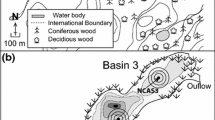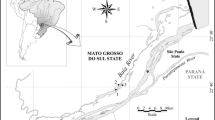Abstract
The characteristic ecology of floodplain lakes is in part due to their relatively strong water-level fluctuations. We analyzed the factors determining water-level fluctuations in 100 floodplain lakes (during non-flooded conditions) in the active floodplains of the Lower Rhine in the Netherlands. Furthermore, we explored the relationship between water-level fluctuations and macrophyte species richness, and analyzed the suitability of artificially created lakes for macrophyte vegetation. During non-flooded conditions along the Rhine, lake water-level fluctuations are largely driven by groundwater connection to the river. Hence, water-level fluctuations are largest in lakes close to the main channel in strongly fluctuating sectors of the river and smallest in isolated lakes. Additionally, water-level fluctuations are usually small in old lakes, mainly due to reduced groundwater hydraulic conductivity resulting from accumulated clay and silt on the bottom. Species richness of floating-leaved and emergent macrophytes was reduced at both small and large water-level fluctuations, whereas species richness of submerged macrophytes was reduced at small water-level fluctuations only. In addition, species richness of submerged macrophytes was higher in lakes that experienced drawdown, whereas no similar pattern was detected for floating-leaved and emergent macrophytes. The decline in amplitude of lake water-level with lake age implies that the number of hydrologically dynamic lakes will decrease over time. Therefore, we suggest that excavation of new lakes is essential to conserve the successional sequence of floodplain water bodies including conditions of high biodiversity. Shallow, moderately isolated, lakes with occasional bottom exposure have the highest potential for creating macrophyte-rich floodplain lakes along large lowland rivers. The water-level regime of such lakes can in part be designed, through choice of the location along the river, the distance away from the river and the depth profile of the lake.
Similar content being viewed by others
References
I. Blindow (1992) ArticleTitleLong- and short-term dynamics of submerged macrophytes in two shallow eutrophic lakes Freshwater Biology 28 15–27
I. Blindow G. Andersson A. Hargeby S. Johansson (1993) ArticleTitleLong-term pattern of alternative stable states in two shallow eutrophic lakes Freshwater Biology 30 159–167
A. Bonis J. Lepart P. Grillas (1995) ArticleTitleSeed bank dynamics and coexistence of annual macrophytes in a temporary and variable habitat Oikos 74 81–92
A. Bonis P. Grillas (2002) ArticleTitleDeposition, germination and spatio-temporal patterns of charophyte propagule banks: a review Aquatic Botany 72 235–248 Occurrence Handle10.1016/S0304-3770(01)00203-0
G. Bornette C. Amoros D. Chessel (1994) ArticleTitleEffect of allogenic processes on successional rates in former river channels Journal of Vegetation Science 5 237–246
G. Bornette C. Amoros N. L. Lamouroux (1998) ArticleTitleAquatic plant diversity in riverine wetlands: The role of connectivity Freshwater Biology 39 267–283 Occurrence Handle10.1046/j.1365-2427.1998.00273.x
G Bornette H Piegay A Citterio C Amoros V Godreau (2001) ArticleTitleAquatic plant diversity in four river floodplains: a comparison at two hierarchical levels Biodiversity and Conservation 10 1683–1701
T. C. M. Brock G. Velde Particlevan der H. M. Steeg Particlevan de (1987) ArticleTitleThe effects of extreme water level fluctuations on the wetland vegetation of a nymphaeid-dominated oxbow lake in The Netherlands Archiv für Hydrobiologie, Ergebnisse der Limnologie 27 57–73
M. Brunke T. Gonser (1997) ArticleTitleThe ecological significance of exchange processes between rivers and groundwater Freshwater Biology 37 1–33
A. D. Buijse H. Coops M. Staras L. H. Jans G. J. Geest ParticleVan R. E. Grift B. W. Ibelings W. Oosterberg F. C. J. M. Roozen (2002) ArticleTitleRestoration strategies for river floodplains along large lowland rivers in Europe Freshwater Biology 47 889–907
Coops, H., J. van Schie & R. W. Doef, 1993. Waterplanten in de Duursche Waarden 31 augustus 1993. RIZA werkdocument 93.134x, RIZA, Lelystad [in Dutch].
H. Coops G. Velde Particlevan der (1995) ArticleTitleSeed dispersal, germination and seedling growth of six helophyte species in relation to water-level zonation Freshwater Biology 34 13–20
H. Coops J. Hanganu M. Tudor W. Oosterberg (1999) ArticleTitleClassification of Danube Delta lakes based on aquatic vegetation and turbidity Hydrobiologia 415 187–191
Coops, H. & G. J. Van Geest, in press. Extreme water-level fluctuations determine aquatic vegetation in modified large-river floodplains. Archiv für Hydrobiologie, supplement Large Rivers.
Duel, H., M. Baptist & W. E. Penning, 2001. Cyclic floodplain rejuvenation: a new strategy based on floodplain measures for both flood risk management and enhancement of the biodiversity of the river Rhine. NCR-publication no. 14, Delft.
N. Giles (1987) ArticleTitleThe differences in the ecology of wet-dug and dry-dug gravel pit lakes The Game Conservancy Annual Review 18 130–133
K. E. Havens B. Sharfstein M. A. Brady T. L. East M. C. Harwell (2004) ArticleTitleRecovery of submerged plants from high water stress in a large subtropical lake in Florida, USA Aquatic Botany 78 67–82
C. P. Henry G. Bornette C. Amoros (1994) ArticleTitleDifferential effects of floods on the aquatic vegetation of braided channels of the Rhone River Journal of the North American Benthological Society 13 439–467
N. M. Hill P. A. Keddy I. C. Wisheu (1998) ArticleTitleA hydrological model for predicting the effects of dams on the shoreline vegetation of lakes and reservoirs Environmental Management 22 723–736 Occurrence Handle10.1007/s002679900142 Occurrence Handle9680540
R. H. G. Jongman C. J. F. ter Braak O. F. R. Tongeren Particlevan (1995) Data Analysis in Community and Landscape Ecology Cambridge University Press Cambridge
P. A. Keddy P. Constabel (1986) ArticleTitleGermination of ten shoreline plants in relation to seed size, soil particle and water level: an experimental study Journal of Ecology 74 133–141
A. Kowalczewski T. Ozimek (1993) ArticleTitleFurther long-term changes in the submerged macrophyte vegetation of the eutrophic Lake Mikolajskie (North Poland) Aquatic Botany 46 341–345
Lauwaars, S. G., R. W. Doef & H. Coops, 1997. Waterplanten in de Blauwe Kamer 1993–1995. RIZA-werkdocument 97.034X, RIZA, Lelystad [in Dutch].
Lelek, A., 1989. The Rhine river and some of its tributaries under human impact in the last two centuries: In Dodge, D.␣P. (ed), Proceedings of the International Large River Symposium. Canadian Special Publication of Fisheries and Aquatic Sciences 106: 469–487.
H. Middelkoop (1997) Embanked floodplains in the Netherlands: geomorphological evolution over various time scales Nederlandse Geografische Studies no. 224 Utrecht
M. J. Norusis (1997) SPSS 7.5 Guide to Data Analysis Prentice Hall New Jersey
V.W. Proctor (1967) ArticleTitleStorage and germination of Chara oospores Journal of Phycology 3 90–92
A. J. M. Smits H. Havinga E. C. L. Marteijn (2000) New concepts in river and water management in the Rhine river basin: how to live with the unexpected AJM Smits PH Nienhuis RSEW Leuven (Eds) New Approaches to River Management Backhuys Publishers Leiden 267–286
A. J. M. Smits R. Ruremonde Particlevan G. Velde Particlevan der (1989) ArticleTitleSeed dispersal of three nymphaeid macrophytes Aquatic Botany 35 167–180
Van den Brink, F. W. B., 1994. Impact of hydrology on floodplain lake ecosystems along the Lower Rhine and Meuse, Ph.D thesis, University of Nijmegen, The Netherlands.
G. J. Geest ParticleVan F. C. J. M. Roozen H. Coops R. M. M. Roijackers A. D. Buijse E. T. H. M. Peeters M. Scheffer (2003) ArticleTitleVegetation abundance in lowland floodplain lakes determined by surface area, age and connectivity Freshwater Biology 48 440–454
Van Geest, G. J., H. Coops, R. M. M. Roijackers, A. D. Buijse & M. Scheffer, in press. Succession of aquatic vegetation driven by reduced water level fluctuations in floodplain lakes. Journal of Applied Ecology.
D. A. Wilcox J. E. Meeker (1991) ArticleTitleDisturbance effects on aquatic vegetation in regulated and unregulated lakes in northern Minnesota (USA) Canadian Journal of Botany 69 1542–1551
P. J. Wood P. D. Armitage (1997) ArticleTitleBiological effects of fine sediments in the lotic environment Environmental Management 21 302–217
Author information
Authors and Affiliations
Corresponding author
Rights and permissions
About this article
Cite this article
Geest, G.J.V., Wolters, H., Roozen, F.C.J.M. et al. Water-level fluctuations affect macrophyte richness in floodplain lakes. Hydrobiologia 539, 239–248 (2005). https://doi.org/10.1007/s10750-004-4879-y
Issue Date:
DOI: https://doi.org/10.1007/s10750-004-4879-y




